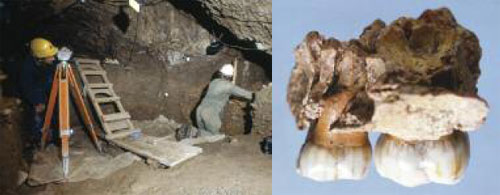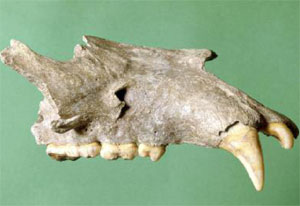
|
PONTNEWYDD CAVE
|
 |
Archaeologists surveying during excavations in Pontnewydd
Cave (left) |
Palaeolithic – The Earliest Humans Discoveries of flint artefacts and butchered bones at the Happisburgh project in Norfolk indicate the presence of hominins (pre-humans) within the Lower Palaeolithic landscape of Britain possibly between 800,000 – 900,000 years ago. These are the oldest such finds yet found from northern Europe, recovered from an interglacial (warmer climate period) deposit together with plant and animal remains that point to a Scandinavian type climate with conifer forest and grassland. These earliest hominins shared their environment with mammoths, lions and hyenas. The first available evidence we have for early humans or Neanderthals in modern-day Wales dates from the later Lower Palaeolithic. Although they belong to the same genus, Homo, as us, they were very different and do not appear to have adapted to their changing environment as well as modern humans. As the ice retreated, Neanderthal men and women moved westwards in pursuit of prey and in Wales found shelter in limestone caves, such as Pontnewydd Cave, in Denbighshire, occupied around 230,000 years ago in the middle of an interglacial, and Coygan Cave in Carmarthenshire where late Neanderthal (60,000 - 35,000 years ago) hand axes have been discovered. |
 |
Palaeolithic flint tools
from Pontnewydd Cave |
